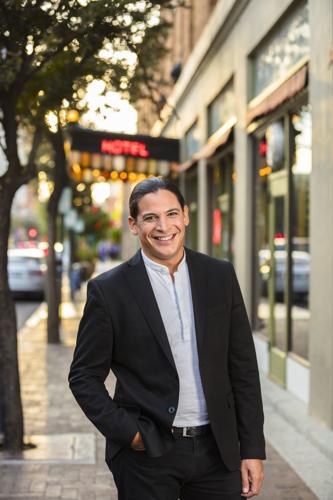Tucson Symphony Orchestra conductor José Luis Gomez showed us a different side to his music-making on Friday night.
Sporting an untucked dress shirt instead of his suit coat and tie, and a violin instead of his baton, he joined a quartet of soloists — concertmaster Lauren Roth, principal violist Anne Weaver and principal double bass player James Karrer — to perform Mozart’s lively Serenade No. 6 in D major.
In the vernacular of the handful of teens among the nearly full house at Catalina Foothills High School: Maestro got mad violin skills.
But the object of his maiden solo venture with the orchestra was not so much to show us he can play the violin; he can, and quite proficiently. “Gomez Plays Mozart” was a chance for us to see where he came from musically and how that informs his leadership of the orchestra.
Now we understand why his players are always smiling. When he’s at the podium, we don’t really get to see his facial expressions and how he communicates with his musicians. But standing in front of them and facing us, we got a glimpse of that reassuring smile that says, “Hey, let’s do this! Let’s make some music!”
It was exhilarating and inspired.
Mozart’s “Serenata Notturna” is a work the composer meant as a lighthearted and frisky conversation mostly led by the twin violins. Roth and Gomez, both terrific musicians, showed us the special chemistry that has developed over Gomez’s first three seasons and has truly made the orchestra better. And seeing them face off, playing off each other’s personality as the piece unfolded, was so much fun.
Gomez pulled his bow briskly over the strings, and Roth followed. He leaned in as he drew two quick jabs with the bow, and Roth followed. He increased the tempo during the minuet, and Roth followed, but always with a wink-wink, as if she was letting him believe she was following, when she was actually leading.
And when he turned to face the audience and raised his eyebrows, as if he was giving us a heads-up of what was to come, Roth’s smile let us know she had a trick or two in her bow as well.
Watching the two of them made us appreciate the orchestra on a more intimate level.
Friday night’s performance was the first time in 30 years that the orchestra has played Serenade No. 6, but it had never before Friday played Mozart’s Serenade No. 12 in C minor that opened the concert.
The work is scored for twin oboes, clarinets, bassoons and horns, which like the Serenade No. 6 gave us a chance to see what we rarely get to see from our spot in the audience.
The winds are tucked behind the strings, shielded by music stands and the elbows of their string colleagues bowing as they are blowing, so we don’t get to see them take the reeds out of their instruments between movements or clean out the spittle by pulling a cloth through the pipe.
The Serenade No. 12 was largely a conversation between the oboes and clarinets, with the horns and bassoons adding percussive exclamation points. It’s alternately dreamy and regal, like the soundtrack to a movie dream that segues to a cotillion ball.
It was especially fun watching the interplay between principal oboist David Barford and principal clarinetist Dario Brignoli. During a delightful romp, Barford and Brignoli swayed and rocked to the rhythm.
The orchestra closed “Gomez Plays Mozart” with Haydn’s Symphony No. 103 in E-flat Major, a piece the orchestra happily revisited after a 19-year hiatus. The concert repeats and again on Sunday, March 10 (see box).





